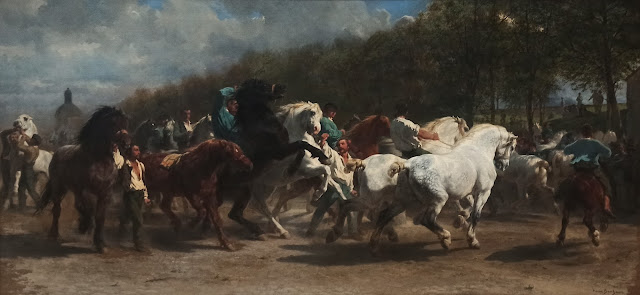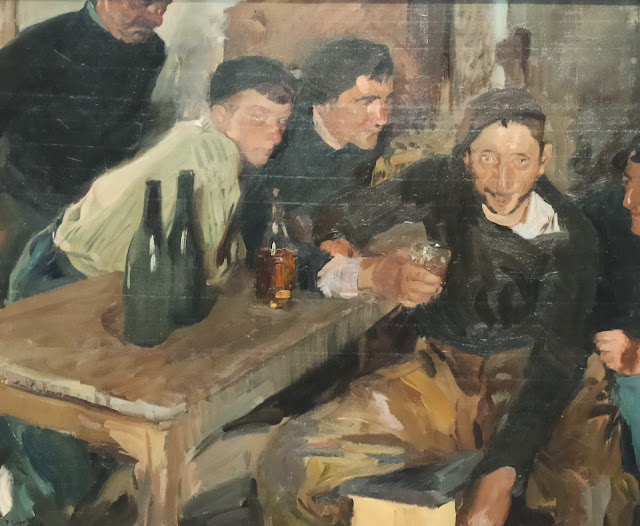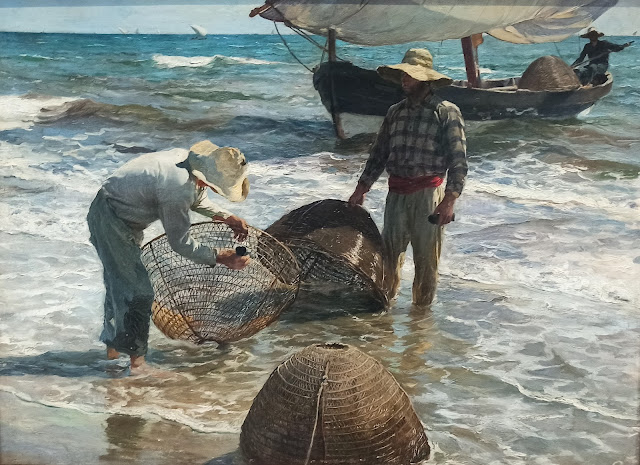These paintings are the August 2023 additions to room 41 of the National Gallery. I covered the works from 2022 in post a few days ago.
Those additions are works by:
- Rosa Bonheur
- Edgar Degas
- Joaquin Sorolla
✲✲✲
The Horse Fair by Rosa Bonheur - 1855
This painting is huge.
I really like how Bonheur has painted her horses with so much vitality. In this painting, she depicted a horse sale. There is something special about that white horse. The way she has painted the bundles of muscles, tissue, and bone affects a movement to the horses in the painting. They have a force and physicality that is astonishing - in addition to the general commotion and noise of the painting.
Rosa Bonheur is a fascinating lady. She was, at the time, one of the most famous female artists of the 19th century across France and beyond. Born in 1822 into a poor family, she became a noted animalière (painter of animals). She made her debut at the 1841 Paris Salon when she was 19 years old.
She seems to have been a true nonconformist and didn’t mind standing-out. She wore trousers (which, at the time, were reserved for men & needed a “permission de travestissement” from the local police) and she had a romantic relationship for most of her life with another lady. Met Queen Victoria and the Emperor of France. Bonheur’s art seems to emerge from the Romantic movement (of the 1830s in France and England). Romanticism has a difficult relationship with nature: to inspire and terrify with nature’s intensity and serenity - by being free of social constraints - whilst also running against realism.
According to the National Gallery, this is “probably Bonheur’s best-known composition, it established her reputation both in France and abroad”.
✲✲✲
Hélène Rouart in her Father’s Study by Hilaire-Germain-Edgar Degas - 1886
Hélène Rouart was the only daughter of Degas’s friend, Henri Rouart. She was an art collector.
There doesn’t seem to be a lot of warm in Helene. Whilst I do like the Egyptian statutes, paintings in the room etc., she does seem to be standing behind the chair with hands resting on it. I am not sure why he painted the chair in front of her. According to the National Gallery, it was her father’s chair and Degas may have wishes to capture something of her child-like quality. The Gallery says: “When Hélène was nine, Degas had painted a portrait of her sitting on her father’s knee“.
Interesting painting around her wrists:
✲✲✲
The Drunkard, Zarauz by Joaquin Sorolla - 1910
This painting is a recent addition to the National Gallery:
The National Gallery has acquired its first painting by the Spanish impressionist Joaquin Sorolla, a huge name in his day who was once audaciously described as “the world’s greatest living painter”.
I liked this painting. I like the commonplace ordinary feel of the painting. It’s a familiar scene of ordinary townsfolk. On the one hand, it could be the boisterous and lighthearted laughter in a pub on a Friday evening; on the other hand, it could be an homage to the blight of alcoholism to the time, money and health of these lads.
It’s hard to tell; but Sorolla gives us a pie-eyed stoned look of the central figure - starring at us - of the bacchanalian crew. It’s quite touching. His friends have leaned in to him which suggests affection.
I love the darker palettes for the trousers:
✲✲✲
Valencian Fishermen by Joaquin Sorolla - 1895
This painting was incredible.
I’m excited about this Spanish artist Sorolla.
I thought I was looking at a photograph. Unlike the other impressionists - who like to have their brushstrokes create uncertain boundaries and to have objects feeling disconnected in some way to the overall painting - Sorolla likes to immerse us in the lives of the ordinary people and show us something interesting with such fastidious brushwork.
I really love this fishing-town scene. Just love it all; the crashing soft waves, the sunny weather, the straw hats, the smooth sandy beach, the seaman’s ordinariness in their clothing, and especially the azure sea. You can almost taste the salty air, and that seaside smell.
I like how the fishermen are checking their wicker traps and hardly seem to notice the viewer. The shadow is incredible. It looks so real in colour and the way it bends and glistens across the shallow waters. Makes me want to book a holiday!
✲✲✲
Monet’s WaterLilies
Already covered before. But it’s just enormous and very engaging.










Bonheur and Degas are well represented in our Australian galleries, but I cannot find a Sorolla. This is a shame because Sorolla's beach, fishing and boating images are very appealing to an ocean-obsessed nation.
ReplyDeleteMany thanks to you and to Conversation:
https://theconversation.com/how-joaquin-sorollas-paintings-shed-light-on-social-realities-211148
Hi Hels,
DeleteHow very interesting. I really enjoyed reading that article and some of the paintings in it (esp Hardness of the Sea) quite moving. I really can't wait to discover his other works in London; but I can see much online. It seems (I think) that I may have missed an exhibition of some kind in London a few years ago ! Might have to travel to Spain (when I'm no longer on a student budget!). Well, thanks for your comment.
That white horse in the first photo is beautiful. Of these paintings, I like Valencian Fishermen the most. I see a return to the National Gallery is required!
ReplyDeleteHi Mandy. Yes, I thought the fishermen by the Spanish Sorolla was the highlight. Amazing. I hope you enjoy your visit to the gallery :) .
Delete